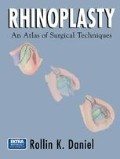Abstract
After inserting several thousand grafts during rhinoplasty operations, 1 have come to 10 conclusions. 1. Grafts must be an integral part of analysis and operative planning for a rhinoplasty and not an obligate intraoperative necessity. The decision to do a tip graft or a radix graft will dictate the amount of dorsal reduction and often the operative approach. 2. One must be adept at using all of the donor materials and not be dependent on only one. Although septum is usually sufficient in primary cases, it is often insufficient in secondary cases and one must be able to make a dorsal or columellar strut from concha. 3. One should be able to harvest a graft quickly. If it is difficult to take grafts, then one will often rationalize why they are not needed. 4. Graft shaping and recipient bed preparation are of equal importance. Often, one will spend considerable time fashioning a perfect dorsal graft only to leave a small prominence in the keystone area which will act as a fulcrum and distort the dorsum. 5. The least done to a graft the better. I am dubious of the long-term survival of crushed and even bruised cartilage grafts; use solid-shaped grafts. 6. Fixation of the graft most often requires sutures with the open approach as one does not have the tight pockets of the closed approach. 7. Antibiotic coverage is important including intravenous dosage during the operation and five days postoperatively. The majority of reported infections do not include antibiotic coverage. 8. Alloplasts may be a short cut for the surgeon, but it increases the risk of failure for the patient. 9. Autogenous grafts rarely extrude, can withstand infection and have definitely stood the test of time. 10. Grafts have dramatically improved the quality of our rhinoplasty result, allowing for a more natural functional primary result, and a heretofore unobtainable nonoperative look in secondary cases.
Access this chapter
Tax calculation will be finalised at checkout
Purchases are for personal use only
Preview
Unable to display preview. Download preview PDF.
References
Aiach G. Atlas of Rhinoplasty. St. Louis: Quality Medical Publishing, 1996.
Anderson JR, and Ries WR. Rhinoplasty: Emphasizing the External Approach, New York: Thieme-Stratton, 1986.
Beekhuis GJ. Saddle nose deformity. Etiology, prevention and treatment: Augmentation rhinoplasty with polyamide. Laryngoscope 1974;84:2.
Burget GC, and Menick, IJ. Aesthetic Reconstruction of the Nose. St. Louis: Mosby, 1994.
Byrd HS, Andochick S, Copit S, and Walton KG. Septal extension grafts: A method of controlling tip projection and shape. Plast Reconstr Surg 1997; 100:999.
Daniel RK (ed). Aesthetic Plastic Surgery: Rhinoplasty. Boston: Little, Brown, 1993.
Daniel RK. Rhinoplasty and rib grafts: Evolving a flexible operative technique. Plast Reconstr Surg 1994;94:597.
Flowers RS. Rhinoplasty in oriental patients: Repair of the East Asian nose. In: Daniel RK (ed) Aesthetic Plastic Surgery: Rhinoplasty. Boston: Little, Brown, 1993.
Guerrerosantos J. Temporoparietal free fascial grafts to the nose. Plast Reconstr Surg 1985;76:328.
Gunter JP, and Rohrich RJ. Correction of the pinched nasal tip with alar spreader grafts. Plast Recontr Surg 1992;90:821.
Gunter JP. Secondary rhinoplasty: The open approach. In: Daniel RK (ed) Aesthetic Plastic Surgery: Rhinoplasty. Boston: Little, Brown, 1993.
Gunter JP, Clark CP, and Friedman RM. Internal stabilization of autogenous rib cartilage grafts in rhinoplasty: A barrier to cartilage warping. Plast Reconstr Surg 1997;100:161.
Johnson CM Jr., and Toriumi DM. Open Structure Rhinoplasty. Philadelphia: Saunders, 1990.
Juri J. Salvage techniques for secondary rhinoplasty. In: Daniel RK (ed) Aesthetic Plastic Surgery: Rhinoplasty. Boston: Little, Brown, 1993.
Kamer FM, and McQuown SA. Revision rhinoplasty. Arch Otolaryngol Head Neck Surg 1988;114:257.
Miller TA. Temporalis fascia grafts for facial and nasal contour augmentation. Plast Reconstr Surg 1988;81:524.
Onsley TG, and Taylor CO. The use of gore-tex for nasal augmentation: A retrospective analysis of 106 patients. Plast Reconstr Surg 1994;94:241
Ortiz-Monasterio F, Olmedo A, and Oscoy LO. The use of cartilage grafts in primary aesthetic rhinoplasty. Plast Reconstr Surg 1981;67:597.
Peck GC. Techniques in Aesthetic Rhinoplasty (2nd ed.) Philadelphia: JB Lippincott, 1990.
Schuller DE, Bardach J, and Krause CJ. Irradiated homologous costal cartilage for facial contour restoration. Arch Otolaryngol 1977;103:12.
Sheen JH, and Sheen AP. Aesthetic Rhinoplasty (2nd ed.) St, Louis: Mosby, 1987.
Sheen JH. Tip graft: A 20-year retrospective. Plast Reconstr Surg 1991;91:48.
Tardy ME. Rhinoplasty: The Art and the Science. Philadelphia: Saunders, 1997.
Tebbetts JB. Shaping and positioning the nasal tip without structural disruption: A new systematic approach. Pktst Reconstr Surg 1994;94:61–77.
Toriumi DM, Josen J, Weinberger M, and Tardy E. Use of alar batten grafts for cor-rection of nasal valve collapse. Arch Otolaryngol Head Neck Surg 1997;123:802–808.
Welling DB, Maues MD, Schuller DE, and Bardach J. Irradiated homologous cartilage grafts: Long-term results. Arch Otolaryngol Head Neck Surg 1988; 114:291.
Additional References
Gryskiewicz JM, Rohrich RI, and Reagan BJ. The use of Allo Derm for the correction of nasal contour deformities. Plast Reconstr Surg 2001; 107:561.
Lovice DB, Mingrone MD, and Toriumi DM. Grafts and implants in rhinoplasty and nasal reconstruction. Otolaryngol Clin North Am 1999;32:113.
Sheen JH. The ideal dorsal graft: A continuing quest. Plast Reconstr Surg 1998; 102:2490.
Author information
Authors and Affiliations
Rights and permissions
Copyright information
© 2002 Springer Science+Business Media New York
About this chapter
Cite this chapter
Daniel, R.K. (2002). Grafts. In: Rhinoplasty. Springer, New York, NY. https://doi.org/10.1007/978-1-4757-4262-6_6
Download citation
DOI: https://doi.org/10.1007/978-1-4757-4262-6_6
Publisher Name: Springer, New York, NY
Print ISBN: 978-1-4757-4264-0
Online ISBN: 978-1-4757-4262-6
eBook Packages: Springer Book Archive

